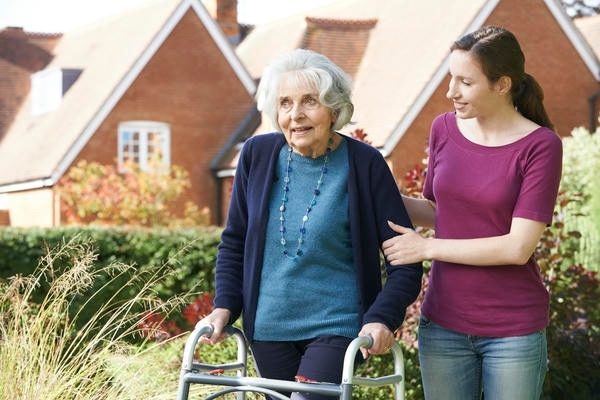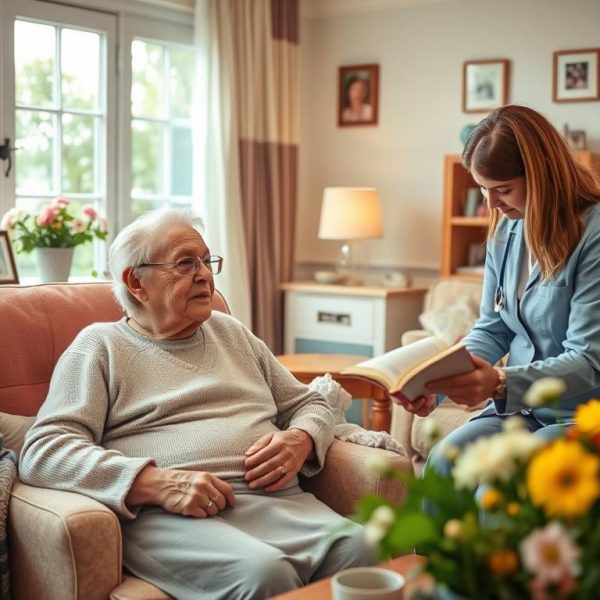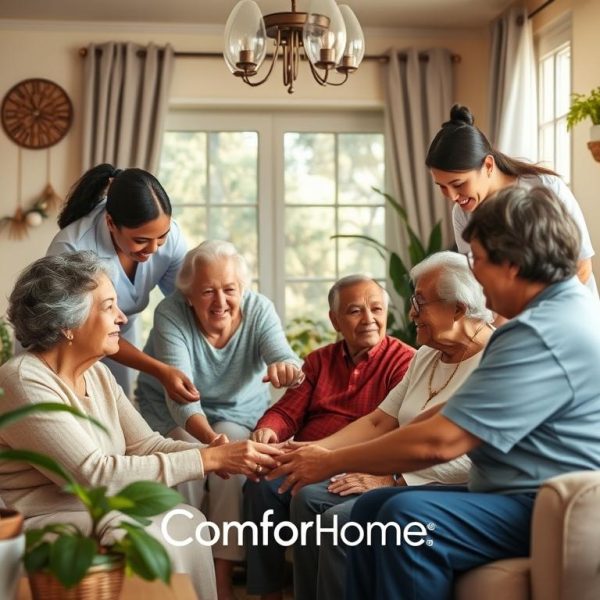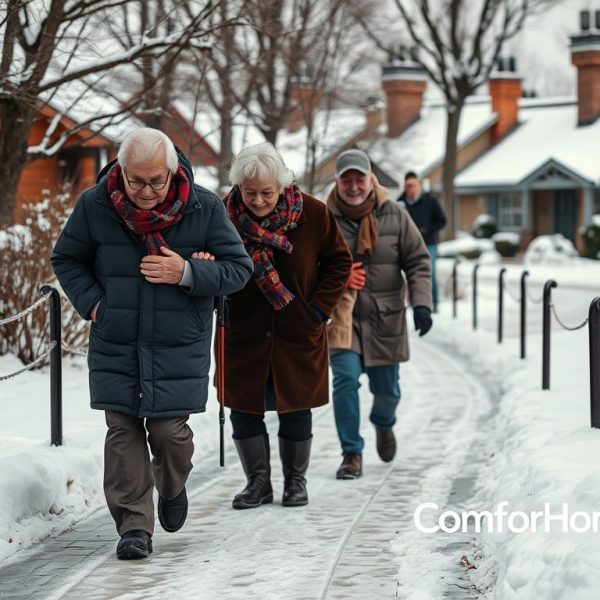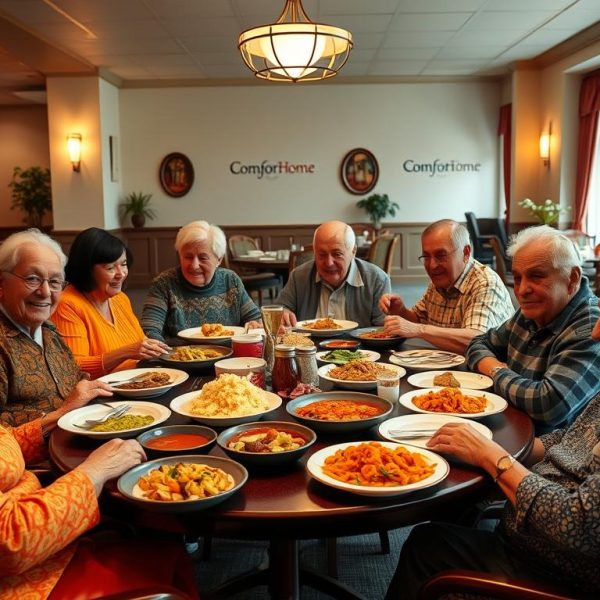Have you ever thought about the quality of elderly care you want to provide for your Canadian loved ones? As we grow older, it also creates a chance for the need for empathetic and complete caregiving. This time, we are taking a look at the key methods that caregivers can adopt to assist Canadian seniors and meet their increasingly complex needs.
Starting from managing health problems to giving emotional support, everything will be discussed. No matter if you are a family caregiver or a health professional, you will find practical ways to improve the standard of living older can enjoy.
Get ready to learn:
• How to balance medical care with emotional well-being
• Tips for promoting independence while ensuring safety
• Strategies for addressing loneliness and depression
• Ways to navigate the complexities of chronic condition management
Join us as we delve into the world of senior care, equipped with insights from healthcare providers, social workers, and experienced caregivers. Let us all take care of the needs of Canadian seniors. On our voyage, we will prove to be the light in their lives.
Understanding the Diverse Needs of Canadian Seniors
(Keywords: older adult, quality of life, elderly parent)
As Canada’s population ages, understanding the diverse needs of seniors becomes increasingly crucial. Each older adult is unique, with their own set of challenges, preferences, and requirements.
For instance, take Maria who is a 75-year-old retiree in Vancouver. She is a techie, practices yoga, and helps with local animal shelters. Thus, her needs are diverse from that of George aged 82, a widower in a remote village of Nova Scotia who is having a hard time walking but enjoys the quiet evenings reading.
The quality of life for Canadian seniors depends on addressing these varied needs:
Physical Health
– Seniors must go through regular health check-ups.
– Seniors must receive proper drug therapy and be educated so that they are aware of the potential obstacles and how to handle them.
– Seniors should be able to exercise with their own limits in mind.
Mental Well-being
– Seniors should join social clubs or go to community centers that are important to them.
– Cognitive powers can be enhanced by providing stimulating activities.
– Information on mental health services must be available to all as a priority.
Social Connections
– Local community groups for elderly people are available.
– Communication technologies are essential to staying connected globally.
– Programs connecting generations are truly effective.
Financial Security
– Knowledge of pertinent programs, preferably free ones, helps retirement planning.
– Benefits provided by the government must be made known.
– Protections against financial abuse must be implemented.
Housing
– Seniors can make their homes more secure through home renovations as well as the provision of smart gadgets to automate specific tasks.
– Qualified, trained staff that can perform the help needed will be recruited.
– Places of residence are enabled by an outside agency that supplies the necessary support.
For adult children caring for an elderly parent, understanding these diverse needs is crucial. It is not enough for them as caregivers simply to realize that the elderly have special requirements; they must facilitate activities that enrich seniors’ lives as well.
Take Sarah, for example. After her father, a retired school teacher starting showing signs of dementia/adult day-care facilities, she discovered that his needs include more than just medical attention. Among other things, Sarah arranged events where her father could teach students through an online video conferencing program thus letting him participate in creating formats.
Revealing the intricacies of elderly people’s life situations leads to better lives for them – life quality instead of just life quantity.
💡 Key Takeaways: Understanding and addressing the diverse needs of Canadian seniors, from physical health to social connections, is essential for enhancing their overall quality of life and well-being.
The Critical Role of Caregivers in Senior Care
(Keywords: caregivers of canadian, caregiving role, family caregiver)
Without a doubt, caregivers of Canadian seniors are the primary agents of health, happiness, and dignity for our older generation. They could either be a professional caregiver or a member of the family, and their influence is immeasurable.
Let’s consider the saga of John, a family caregiver from Toronto. His mother’s Parkinson’s disease diagnosis put him in the caregiving role, which changed both their lives. The thoroughness with which John took care of his mother, from administering medications to providing emotional support, shows the deep impact that caregivers can have.
Various responsibilities are taken on under the umbrella of caregiving:
Daily Assistance
– Cleaning help
– Preparing healthy meals
– Making them move
Health Management
– Organizing medical appointments
– Giving the patient medications
– Following up on health status
Emotional Support
– Accompanying the patient
– Helping them in social interactions
– Lending a compassionate ear
Advocacy
– Getting them through the maze that is the health system
– Making sure that older people’s rights are respected
– Taking part in the senior’s decision-making process
According to reports from sources such as StatsCan, Family caregivers are the people who are those who carry the major part of home care for seniors, be the ones who juggle the overall responsibility with their own personal and professional lives. This is a challenging but very rewarding role and the foundation of the Canadian senior care system.
Professional caregivers have specific skills and knowledge compared to family caregivers. Together, they build an incredibly versatile network that is the backbone of the enhancement of Canadian seniors´ quality of life.
💡 Key Takeaways: Both the family members and the professionals are caregivers who constitute a significant part of the total care and support system for Canadian seniors. They directly relate to their psychological well-being, health, and quality of life.
Health and Medical Care Management
(Keywords: healthcare provider, medical care, home care)
For Canadian seniors, effective management of health and medical care is a part of staying healthy. This is a joint effort between caregivers, health professionals, and the seniors.
Let us take the case of a woman aged 80 living in the suburbs of Montreal who is Emma. Her medical condition includes incompatible diseases, diabetes, and arthritis, demanding a complex regimen for her treatment. Her daughter Lisa works closely with Emma’s healthcare provider to make sure Emma gets the whole range of medical care.
Key Aspects of Health Management:
1. Regular Health Check-ups
2. Medication Management
3. Chronic Disease Monitoring
4. Preventive Care
5. Emergency Preparedness
The health management of many seniors heavily depends on home care. They can get the required medical attention in the comfort of their home that would then help them to recover faster and reduce stress.
For instance, after Emma’s recent hip surgery, her healthcare provider arranged for home care services. This included visits from a nurse to change dressings and a physiotherapist to guide her through recovery exercises.
Chronic Condition Management
(Keywords: practical knowledge, challenges of elder care)
One of the highest complicated challenges of elder care is chronic condition management. It necessitates practical competencies and an ongoing commitment from caregivers and the elderly alike.
Take diabetes management, for instance. Emma’s caregiver must:
– Keep track of blood sugar levels consistently
– Inject insulin wherever the need arises
– Organize and create meals that meet diabetic requirements
– Support regular exercise programs that fit Emma’s capability
The chronic condition management of older persons other than their medical needs is really complicated and demanding. It encompasses:
– Instructing the senior on sickness and medication
– Persuading him/her to follow the prescribed treatments
– Changing care processes according to the state of progression of the sickness
Sometimes, caregivers are required to acquire extensive health condition knowledge such as diabetes or Alzheimer’s. This might involve attending workshops, consulting with healthcare providers, or joining support groups for caregivers managing similar conditions.
Medication Administration and Vital Sign Monitoring
(Keywords: practical skill, best possible care)
In the healthcare field, giving the right medicines and checking the body’s vital signs are a precondition for the proper functioning of the body. This proficiency represents a practical ability that is paramount to the realization of the highest level of elder care.
In terms of medication administration:
– The medications can be filled in a pill organizer.
– Medication administration can be confirmed by gathering the times in the form of reminders.
– A detailed record of the medication that was taken can be maintained.
Monitoring of vital signs might include:
– Checking blood pressure regularly.
– Measuring heart rate.
– Keeping a check on weight changes.
Lisa, Emma’s daughter, uses a smartphone app to administer her mother’s medications and to log her vital signs. She showed the readings to the doctor whenever she took Emma to a check-up.
Through the practical skills applied, no one would only take one set of prescribed medicines at the time of doctor’s check-up if they were the only issues affecting their health, but the doctor was going to examine their whole health. No health condition would be left to time by the doctor, it’s all about proactive health management.
💡 Key Points: Proper management of seniors’ health and medical care is made possible by the collaborative efforts of healthcare professionals, home-care services, chronic condition management, practical caregiving skills, and comprehensive and personalized care.
Emotional and Psychological Support
(Keywords: emotional support, social work, hospice care)
Emotional and psychological support is essential for a senior care program. It involves the support of both the mind and the body to have a successful and fulfilled later life.
For example, the case of Robert, a 78-year-old widower in Edmonton, who lost his wife of 50 years, can be discussed here. Robert became extremely lonely and depressed after his wife’s death. His carer, Sarah, understood that Robert needed some emotional support beyond merely physical care.
Key Aspects of Emotional Support:
1. Supreme Involvement
2. Distress Alleviation
3. Phasing Out the Unspeakable
4. Fostering Healthy Networks
5. Determine the State of Affairs
Social workers assume an important position in advising senior people without emotional support. Social workers can:
– Determine psychological problems
– Offer counseling
– Place seniors in useful community programs
– Speak on behalf of seniors
In hospice care, emotional support is very important because it is the way in which a person can die with comfort, dignity, and peace. A dying person receives assistance and affirmation from a hospice caregiver through:
– Social sharing
– Religious guidance (if desired)
– Help in writing a life timeline and finding a legacy
– Counseling their families
Addressing Loneliness and Depression
(Keywords: focus group, caregiver experience)
One of the most serious problems for seniors is the feeling of being lonely and depressed. Tackling these problems requires having a systematic approach to them and often the sharing of caregiver experience.
Some of the strategies might be:
– Holding social meetings regularly
– Video calling with family and friends
– Joining in community events
– Using animal therapy
Sarah, in the situation of Robert had a new focus group that had been created for seniors in the neighborhood every week. They shared experiences, played games, and started to read a book, thus recognizing each person. By virtue of the socializing that was done on a regular basis, Robert’s mood improved greatly, as did his optimism.
Caregivers can also draw from their experiences to identify signs of depression early. These might include:
– Changes in sleeping patterns
– Loss of interest in favorite activities
– Decreased appetite
– Expressions of hopelessness
By recognizing these signs early, caregivers can seek professional help promptly, ensuring seniors receive the support they need.
💡 Key Takeaways: Emotional and psychological support, including addressing loneliness and depression, is crucial for seniors’ overall well-being, requiring a multifaceted approach involving caregivers, social workers, and mental health professionals.
Assistance with Activities of Daily Living (ADLs)
(Keywords: essential service, support service)
Assistance with Activities of Daily Living (ADLs) is an essential service in senior care. It’s about helping seniors maintain independence and dignity in their day-to-day lives.
Meet Alice, an 85-year-old living in Halifax. While her mind is sharp, arthritis has made some daily tasks challenging. Her caregiver, Tom, provides crucial support services to help Alice navigate her day with comfort and dignity.
Common ADLs Include:
1. Personal Hygiene
– Bathing
– Grooming
– Oral care
2. Dressing
– Selecting appropriate clothing
– Assistance with putting on and taking off clothes
3. Eating
– Meal preparation
– Feeding assistance if needed
4. Mobility
– Transferring from bed to chair
– Walking assistance
5. Toileting
– Using the bathroom
– Maintaining continence
The assistance rendered for ADLs or Activities of Daily Living is geared toward meeting all the requirements of the individual. A relevant example is that Alice cannot manage buttoning her shirt and lacing her shoes, but she can perform forms of her individual hygiene.
The bunglers who implement ADL aid have to make a careful equilibrium between help and independence for these old folks. As an illustration, Tom personalizes clothes placing them in decent order but does a lousy job at lacing shoes like Alice does herself. Of Note, help is to be found at home.
Technology can also come in handy in support of ADL helpers. The use of the voice-activated device in the smart home allows her to control lights and the temperature as a way of improving her independence.
Always topic, ADL assistance is more than just your roommate. The guiding principles of dignity, facilitation of independence, and quality of life are all that need to be done to achieve your goals. With competence and respect, this can lead to changes in attitude and behavior, resulting in an enhanced feeling of self-esteem among the elderly using the service.
💡 Key Takeaways: Assistance with Activities of Daily Living is a vital support service that helps seniors preserve independence and dignity, should be done through an individualized methodology that ties together the unavoidable help with the required assistance for self-reliance.
Ensuring Home Safety for Seniors
(Keywords: integrated unit of care, caregiver dyad)
Creating a protected space to stay is very important for seniors aging in place. At its core, it is an integrated unit of care that involves both the senior and their caregiver, the caregiver dyad working together to act for safety and the keeping of independence, the adaptation of the house for the seniors, and the provision of support from caregivers for seniors.
Let’s analyze the Thompson family’s situation in Winnipeg. After learning that his 79-year-old mother, Margaret, was having problems with her balance, son David was determined to make their house as safe as possible.
Acquiring Home Safety Measures:
1. Prevention of Falling
– Disposition a hand on both sides of the stairs by putting handrails
– Neaten up all the loose rugs or get rid of them altogether
– Make the lighting great, especially on the stairs and the bathrooms
2. Ensuring Bathroom Safety
– Incorporate grab bars near the toilet and in the shower
– Propose non-slip mats in the bathtub and shower
– Think of a walk-in bathtub or shower chair
3. Kitchen Precautions
– Rank the items on the list that are most often used and put them at a height that would be easily handled
– Besides, appoint automatic shut-off devices on stove and other appliances
– Furthermore, use brighter colors for countertops and floors to make them more visible
4. Safety in the House
– Set up smoke and carbon monoxide detectors
– Put the emergency numbers in big letters next to each phone
– As a bonus, the medical alert system for immediate access to necessary assistance should be taken into consideration
In the process of these changes, David and Margaret were always together. Margaret pointed to the places in the house that trouble her, while David together with her found the answers to the problems and solved them.
Bear in mind; home security is a persistent process. Different evaluations should be done regularly due to any number of factors that could come as a result of a senior’s lifestyle changes over time.
💡 Important Points: To guarantee home safety for seniors, a shared effort by the senior and a caregiver to execute precautions is necessary to guarantee a risk-free living space while still encouraging the seniors’ independence.
Nutrition Support and Meal Planning
(Keywords: valuable resource, benefits of face)
Good nutrition is the bedrock of senior health, so and meal planning are significant resources in caregiving. It’s not just about giving food but also about ensuring that seniors get the nutrients they need to stay healthy and enjoy the social benefits of face-to-face meals.
Frank, the 72-year-old retiree from Calgary, is one example. Frank was not able to cook for himself following the death of his wife. He would often go for unhealthy convenience foods. The caregiver Lisa recognized the need for nutrition support.
Critical Aspects of Nutritional Support:
1. Balanced Meal Planning
– Include a mix of fruits, vegetables, whole grains, and lean proteins.
– Adapt meal plans based on dietary restrictions (e.g., low sodium for hypertension).
– Plan for suitable portion sizes.
2. Hydration
– Point out the importance of drinking water regularly.
– Provide options like herbal tea or flavored water.
3. Special Nutritional Needs
– Address age-related alterations in the absorption of nutrients.
– Refer to a dietitian for individual guidance.
4. Meal Preparation Assistance
– Go grocery shopping with them.
– Give advice in the areas of cooking or meal preparations.
– Implement safe food storage methods.
5. Eating Environment
– Have a delicious and elegant presentation during a meal.
– On occasions, have meals together, thereby socializing.
Lisa stepped in to help Frank by preparing a weekly meal schedule, clarifying simple recipes, and ensuring that he is a part of a lunch club for the elderly on a weekly basis. The social aspect of partaking in meal activities revealed a positive side that started to elevate Frank’s spirit and cheer him up, thus he was more than willing to eat with friends.
It’s worth remembering that nutritional assistance is much more than what goes into the body as food. Rather, it’s about building fun-filled moments with oneself wherein you consume healthy stuff while also having fun.
In the case of seniors who find chewing and swallowing challenging, it is best to offer foods in a texture that is easy to eat but still nutritious such as smoothies, mashed potatoes, and fibrous fruits.
💡 Key Takeaways: Nutrition support and meal planning are critical elements of elder care, providing not only physical sustenance but also social and emotional support through well-designed, fun meals.
Transportation and Mobility Services
(Keywords: mode of access, remote participant)
Senior citizens rely on transportation and mobility services in order to maintain their independence and social connections. Such services are instrumental in connecting seniors with health care, social activities, and daily needs.
Helen, an older adult aged 82, is a practical illustration. She lives in a small village just outside Ottawa. After her driving license was suspended, Helen was left out of all social events until her son, Mark, who was also her primary caregiver, provided a creative solution to her transportation challenge!
Key Transportation and Mobility Services:
1. Public Transit
– Educate seniors about local bus/train routes
– Help seniors get on-board the public transit system by applying for passes
2. Assist in Transit Programs for Seniors
– Organize local transportation companies
– Include students as volunteer drivers for seniors
3. Halfway Point in Transportation Apps
– Show retirees how to operate the transportation app
– Set user profiles with probably the most secure setups
4. Supplies to Get Around
– Devices designed to enable easier mover ability
– Ramp system that you can use anywhere
5. Online Involvement Options
– Video call events for remote attendance
– Health care options over the phone
Mark showed Helen how to interact with a ride-sharing app on her phone. She would use the video call option again for this week’s book club, trying to work it as a remote participant through device very targeted to her involvement with elderly ones.
Keep in mind that transportation is much more than just reaching the destination. Rather, maintaining connections, being able to access services, and involvement in the community are essential components of the transit process. When physical travel is impossible, the options to use technologies to participate in remote activities can help seniors connect and interact.
💡 Key Takeaways: The backdrop of transit and mobility is central to independence in the community for most seniors. Effective and safe means of getting around would include, besides public transit, technologies that give seniors the ability to participate remotely.
Cutting Personalized Care Plans
(Keywords: specialized navigator, palliative pathway)
Professional and customized care plans are one of the priorities to deliver the best senior care a person can give. Contrary to the one-size-fits-all approach that might reflect, these activities are ensured with the factoring of the particularly significant demands, preferences, and situations of each person.
As we consider the case of 76-year-old Amelia living in Vancouver and suffering from heart disease in an advanced stage, we will quickly come to the conclusion that health professionals are the ones that get the support of palliative treatments thus providing an all-encompassing personal care plan. In developing the plan, her care team, comprising a palliative navigator, worked together as a unit.
Key Components of a Personalized Care Plan:
1. Health Assessment
– Current medical conditions
– Medications and treatments
– Physical and cognitive abilities
2. Personal Preferences
– Daily routines and habits
– Dietary preferences
– Cultural or religious considerations
3. Social and Emotional Needs
– Family and social connections
– Hobbies and interests
– Mental health support
4. Environmental Factors
– Home safety assessment
– Necessary adaptations or equipment
5. Care Goals
– Short-term and long-term objectives
– Quality of life priorities
6. Support Network
– Family caregivers
– Professional care providers
– Community resources
In creating intricate care plans for the elderly with complicated or advanced diseases, the palliative navigator approach is the most valuable tool. In this way, the patient is assisted by a specialized
Conclusion
In this comprehensive guide, we’ve explored 13 essential ways caregivers empower Canadian seniors, addressing their diverse needs with compassion and expertise. From managing health concerns to providing emotional support, caregivers play a crucial role in enhancing the quality of life for older adults. By implementing personalized care plans, ensuring home safety, and promoting independence, caregivers create a nurturing environment that allows seniors to thrive.
As we have been aware, the journey of a caregiver is both hard and pleasurable. It needs a lot of hard work, experience, and a broad understanding of the issues faced by people in need. Adopting these strategies and constantly learning can allow caregivers to take action and be a great help to the Canadian elderly’s life.
Do not forget that you are a very important part of the work of a caregiver. You are the one who makes the difference and gives a kind of support which preserves the dignity of the elderly and their comfort. While continuing in this very satisfying task, realize that definitely, you are someone who has a great influence on the lives of those who are under your care.
